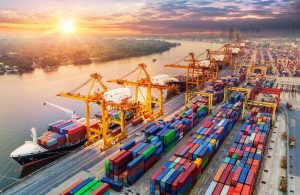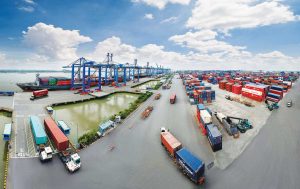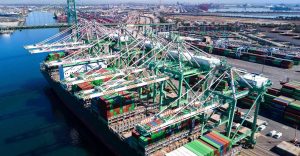As everyone knows, the role of seaports is extremely important for the economic development of each country. Seaports not only play a key role in promoting the growth of the maritime economy but also contribute to the overall development of the nation. They are the primary connection point for conducting trade, transporting import and export goods, and also serve as a central hub for transferring between different modes of transportation, such as from sea to inland waterways, rail, and road.
1. Tasks, roles, and functions of seaports in the economy of each country
A seaport refers to an area consisting of both land and water sections, equipped with modern technology to serve the docking, departure, cargo handling, and passenger services. While seaports often have multiple types of piers and wharves, they generally fall into several categories:
Seaports are classified into various types, including: Commercial ports, Military ports, Fishing ports, and Shelter ports. Among these, commercial ports are further divided into: Natural seaports, River-sea ports, Inland ports, International ports, Integrated ports, and Specialized ports.
1.1 The primary role of seaports for each country
As an infrastructure facility, seaports act as a hub for international trade in the process of transporting goods. Goods are unloaded from ships, stored, processed, packaged, and then distributed to other destinations worldwide. As an important gateway for international trade, seaports play an undeniable role in the movement of goods. The use of seaports helps minimize transportation costs and time, while enhancing flexibility and efficiency in warehouse management.
Services provided at seaports, such as storage, loading/unloading, packaging, and other logistics services, are essential in the supply chain of goods. Additionally, major seaports contribute significantly to the local and national economies by providing employment opportunities and creating new business prospects for enterprises.
In the process of transporting goods, selecting the appropriate seaport and utilizing them effectively is crucial for businesses to optimize operations, meet customer demands, and ensure the integrity and safety of the cargo.
1.2 Important functions of seaport operations
Key functions of seaports include:
- Providing services to support ships docking and departing from the port.
- Serving the transportation, loading/unloading, and storage of goods within the port.
- Providing necessary equipment, tools, and labor to support ship docking, cargo handling, and passenger services.
- Offering protection, repair, and maintenance services for ships in case of emergencies.
- Acting as a connection point with the external transportation system.
- Providing other services for ships, people, and goods.
Seaports play a critical role, especially in the global economy and the development of the maritime economy in each nation and territory.
2. Major seaports in Vietnam and the world
Both Vietnam and the world have many major seaports that meet the needs of cargo transportation and tourism:
2.1 Major seaports worldwide
Some major seaports around the world include:
- Shanghai Port (China): The largest seaport in the world, located at the Yangtze River basin, capable of handling massive volumes of cargo.
- Singapore Port: A strategic seaport located along Asia’s maritime transport routes, playing a vital role in cargo transportation and tourism in the region.
- Rotterdam Port (Netherlands): Known as the largest seaport in Europe, serving as a transportation hub for Western Europe.
- Dubai Port (UAE): A strategic seaport on the Middle East’s shipping routes, playing an essential role in cargo transportation and tourism in the region.
2.2 Major seaports in Vietnam
Some major seaports in Vietnam include:
- Hai Phong Port: The largest seaport in Vietnam, playing a crucial role in cargo transportation in the northern region.
- Đình Vũ – Cát Hải Port: A group of deep-water ports in Hai Phong, built to meet international cargo transportation needs.
- Cát Lái Port: The largest seaport in Ho Chi Minh City, serving as the transportation hub for the southern region.
- Quy Nhon Port: Located in Binh Dinh Province, this seaport plays a vital role in cargo transport and tourism in the area.
3. Updates on new trends in seaport operations today
Now, let’s take a look at new trends in seaport operations, especially those focusing on containerized cargo transportation by road, sea, and rail, which Boom Logistics is proposing for businesses.
The development of technology and applications in seaport operations
Seaports in Vietnam are integrating modern technologies to manage and operate cargo transportation. Among the popular technologies, the Terminal Operating System (TOS) is widely applied. This system helps seaports manage cargo loading/unloading, transport, and storage more accurately and efficiently. At the same time, it increases flexibility in port management and quickly meets customer demands.
In addition to TOS, seaports also use other advanced technologies such as Warehouse Management System (WMS), Transport Management System (TMS), Track and Trace System, Intelligent Transportation System (ITS), Automated Container Terminal (ACT), and Communication Systems.
These technologies enhance productivity, reduce unloading time, optimize the transportation process, improve service quality, and increase convenience for port users. Using these technologies also helps seaports enhance their competitiveness and contribute positively to the economic development of the local and national levels.
Being able to grasp and quickly apply new trends in seaport operations plays an essential role in bringing practical benefits to each country and the enterprises involved in global import and export activities.
The trend of using smart and sustainable seaports
In today’s integration and development era, building and developing smart seaport models has become a key priority for coastal countries worldwide, and Vietnam is no exception. With the advent of the Internet of Things (IoT), seaports and related areas have become too vast and busy to implement comprehensive digitalization. However, recent technological initiatives and revolutions have strongly driven the adoption of integrated processes, transforming port operations.
Furthermore, the application of Blockchain technology also plays an essential role in the digitization strategy of seaports and logistics services. By improving planning and forecasting processes through data utilization, it has brought benefits in enhancing pre-arrival planning at seaports, reducing transaction costs, and improving cargo transport cycles.
Recent planning methods provide earlier visibility, enabling more accurate tracking of cargo movements. It can be confidently stated that smart seaports mark a significant change for supply chains, positively affecting the maritime economy sector. Reducing cargo transport cycle times, easier forecasting, and reliable data on operations in a network environment have brought unprecedented processing efficiency in maritime transport and logistics.
With the government’s efforts to promote trade through participation in regional and international Free Trade Agreements, Vietnam’s seaport system is expected to continue to grow at double-digit rates, in line with commercial activities. The growth outlook for Vietnam’s seaport system is expected to bring positive changes when implementing several Free Trade Agreements such as CPTPP, EVFTA, RCEP…
The importance of seaports worldwide has been demonstrated for organizations and businesses involved in import and export to stay updated. In response to new trends, the smart seaport model is also being widely implemented in many countries to boost the maritime transport industry. Therefore, understanding the functions, tasks, importance, and roles of seaports is crucial. If you need to use container sea freight services or customs clearance at seaports with reasonable pricing, please contact our Hotline below.






